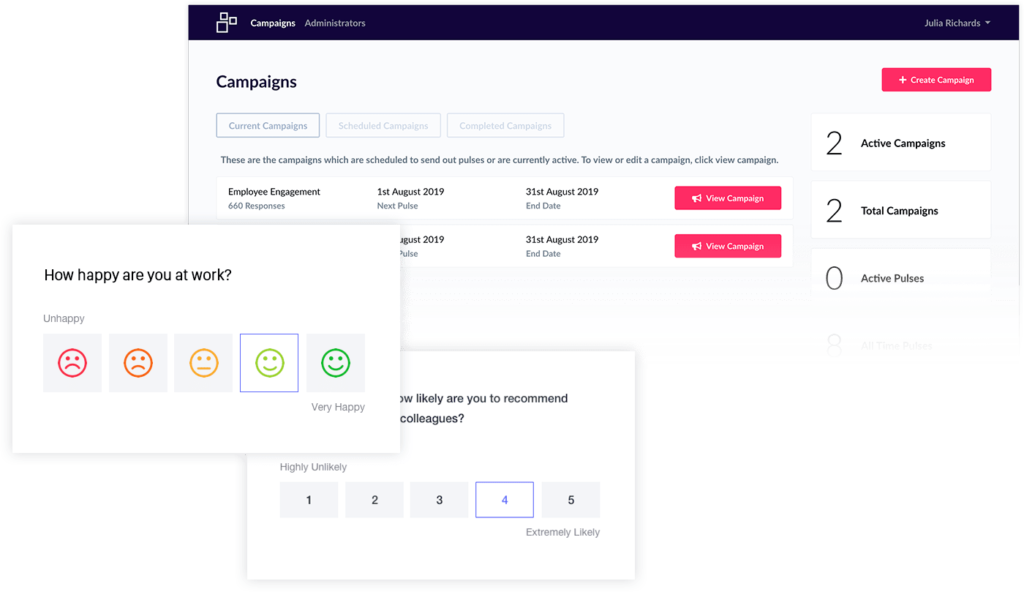Recent data has revealed that some of us have fared better than others during the lockdown. As offices reopen and businesses are encouraged to get back to normal, we look at how internal communications can provide the right approach in supporting our workers in one of the most disruptive periods of our time.
The UK government is urging employees to return to the office. US employees will be following suit shortly after. As we welcome our workers back, we need to readjust our focus from crisis comms and figure out what our employees need to make their return as comfortable and stabilizing as possible.
How we manage our internal communications is critical right now. Employees rely on their connection with their organization to provide them with the direction and reassurance they need. So, what can we do to navigate our way out of this period, as intact as possible? And how do we look after our number one asset: our people?
How internal comms has performed so far

According to the research carried out recently, the general consensus is that most organizations have managed the crisis well. Data shows that organizations scored high in addressing basic needs for safety and promoting stability and assurance. As far as crisis communications go, most of us aced it.
Back in March, the instructions from the government were clear cut. Stay home; keep safe. Organizations managed round this, and successfully overcame the relatively minor challenges of moving an entire workforce home and communicating each step of the way. Now, as we try to re-emerge, the guidance is not as definitive. We should return to offices and workplaces, but if we’re OK where we are, is it safe – or even necessary? Some employees are at more risk than others, so should they remain at home? And for the countless parents who are now managing children during the summer break, what are their options?
And then there are the dark clouds that are gathering over the economy. How do we shape our communications to steer through the inevitable storm that lies ahead? Just as we dust ourselves down from isolation, how do we prepare for such an uncertain future?
This limbo period is giving us time to examine the varied needs of our employees. By considering the various situations our people are in, it’s clear that we can’t apply the same approach to everyone. Coming out of this period requires a more nuanced, thought out handling of the different needs and wants of our people.
The next phase

A study undertaken by McKinsey surveyed 800 employees in the US. The research looked at the various domestic scenarios and measured the positivity levels of each individual. The results were enlightening, with the most revealing being the differences between fathers and mothers – the former viewing working from home more positively than the latter.
But it also showed that those in families adjusted better to the changes that those who were in more isolated situations.
What the McKinsey research demonstrates more than anything is that even when people facing similar circumstances, the experiences and outcomes of each individual can vary widely.
Which should inform the way we manage the next phase. No two employees have shared the same experience in this period. We must be mindful of the various capabilities, outlooks, experiences, and other differences that make up the workforce.
Making the necessary changes

This regard for a more tailored approach will be responsible for radical developments. Businesses will face a lot of change over the next few months. Many of these changes will be driven by the needs and desires of the workforce.
One of the most significant transformations we will see is the location of our work. After months of working from home, there has been a shift of mood, and more flexible policies need to reflect that. After all, research has shown that a considerable percentage of workers perform better at home. And there are many others who are not willing to experience the expensive and time-consuming commutes to the office. Inevitably, staff members will reason the legitimacy of working from home, and organizations will have to amend policies accordingly. A more amenable attitude to remote working will be a necessary adjustment. Returning to enforced office working will inevitably force some workers to look for more tolerant employers. While you may need to say no to employee requests for flexible work that take things too far, it’s important to understand that this flexibility may be key to retention.
This is just one example of how organizations will shape to the wants and needs of the workforce. Where we work is adapting to how we work. This customizable way of working will be reflected in our post-COVID comms. The crisis has exposed how varied our many circumstances are. Employees are now expecting an approach that meets their own particular situation and addresses the challenges they now face.
And with the range of services, tools and technologies available to use now, it is easily possible to deliver this in an effective, targeted way.
How to provide effective post-COVID communications
Going forwards, your internal communications needs a four-pronged approach:
Direction

Employees need communications about the plans, ambitions, and general direction for the business. They need to know if they will still be required in the foreseeable future. There may have been a period of disruption as redundancies and restructuring have taken place. However, returning to the office, leadership needs to step up to the plate and present a plan for the twelve months ahead.
The future might pose many challenges, which is why it’s essential to convey honesty about these potential obstacles and confidence that the organization can weather the storm. As leaders of your organization, this is the time to strike that balance, as McKinsey recommends, “Optimism that springs from authentic values and trust in people’s capabilities can be the source of energy for everyone in the organization to move forward. By contrast, optimism without meaning or grounding may lead to disappointment and defeat.”
Transparency

Many organizations tend not to share too much with their employees. As long as they provide everything the worker needs to fulfill their job, this relationship with the organization doesn’t require further complications. However, events around COVID-19 changed the dynamics between the employee and employer. Rather than have the intangible threat of something like an economic downturn, the pandemic has been something that affected everyone immediately.
Even the most aloof senior leader became more human, as their Zoom meetings and phone calls were disturbed by family members and general domestic interruptions. With these shared experiences and glimpses of family life, the relationship between boss and worker has become a little more personal. Organizations should harness this relatability and consider sharing more details about the health of the business. This kind of transparency can expand relationships, further understanding, and increase engagement.
Trust

The move to remote working worked out pretty well for most organizations. While setting up a workspace at home didn’t come without its problems, employees soon realized the new working conditions came with its benefits. Removing the commute and enjoying a more flexible way of working provides more time to spend with families, keep up with domestic admin, and enjoy more free time.
Organizations have not seen any significant decline in work, either in quality or quantity, and employees have been shown to make up any lost time later in the day. This home working experiment demonstrates that there is value in allowing individuals not to fulfill all their hours in the office. The most significant outcome has been the newly founded trust that employers now have in their workforce. They’ve proven that it works, and it doesn’t diminish the standard of output.
Compassion

The pandemic has, first and foremost, been a human tragedy and will have inevitably affected employees in varying degrees. Whether it’s been losing a family member or friend, physical illness, or a downturn in mental health, very few have escaped this period unscathed. This is why a “business as usual” approach to comms will not work.
Your employees will be returning bruised and battered by the negativity and relentless anxiety of the last few months. It’s important to provide communications that take these various experiences into account and strike a chord with your workforce. A calm, compassionate voice will be far more effective in letting your employees know that their safety and wellbeing is the prime concern.
While it rests on the entire business to collectively ride out this period, internal comms will be leading the way with direct, confident comms that will provide the succor needed to move forwards.
So how do we provide an individual comms approach to our workforce?

The average organization is a combination of a lot of personalities, characters, outlooks, and mindsets. Everyone will have their own personal experience of the first half of the year, unique to them: some will be embracing the re-emergence into some kind of normality. Others may miss the insular nature of life in lockdown. Every person in your organization will have a completely different experience of the past four months – and it’s up to you to recognize and manage this.
There are several ways of using the internal communications tools within your digital software to assist this:
Pulse surveys

By gauging the mood of your workforce, you can work out the many challenges facing them, and work out how you can manage them through pulse surveys.
Employees can give an opinion on a wide variety of subjects: how they feel about their job, their opinion on the handling of the crisis, whether they feel they want to return to the office. As an internal communicator, you can create an array of questions that help build a picture of where your people are up to right now.
DO: Use pulse surveys every few weeks during crisis points to detect trends and work out what things you need to address.
DON’T: Avoid acting on the results. Your surveys and polls will produce valuable insights – if you don’t work with the feedback given, your employees will stop answering them.
Personas

Finding out what motivates people, what they’re finding frustrating them, and their requirements allow you to deliver information and conversation and develop a culture that connects with your workforce. Personas also help deliver more effective communications. When you know who you’re targeting, you’re able to provide a more empathic message – something your workforce needs right now. When an employee receives internal communications aimed explicitly at their situation, engagement increases, and people are more likely to respond.
DO: Use personas to define different groups for parents, those who face a lengthy commute, workers who live by themselves, and those who fall into the “at-risk” category.
DON’T: stick with the same personas time and time again. Like your business, your workforce will evolve, so personas will need to be reassessed regularly.
Broadcasts
Employees will want to know that they’re being kept in the loop, but when the working day is done, it is unreasonable for them to keep checking the intranet or emails to stay informed. That’s why Broadcasts have proven so useful this year, particularly in a rapidly changing news cycle at the beginning of lockdown. The Broadcasts feature pushes urgent updates through homepage banners, email, and SMS, so employees are alerted to significant news on their personal devices.
DO: Use Broadcasts to communicate big news, for example, if a member of staff has been diagnosed with the virus, and the people with whom they’ve shared the same space need to return to isolation.
DON’T: Use this feature frequently. Overuse of Broadcasts can lead to loss of impact, so use sparingly.
Leadership blogs

It’s our leaders whom we immediately look to during times of crisis, change, or uncertainty. Right now, their every movement is being monitored by a workforce hungry for information. All senior-level management members will need to be attuned to the role they serve and the need for reassurance and stability. This is why organizing a series of calm, compassionate, and strong communications with employees are so important. Right now, even the most reticent leaders should be using their voice – after all, not saying anything is saying something.
Leadership blogs are so important in delivering a measured, confident message to the organization. At a time of uncertainty as we plan for the ‘new normal’, a vlog or blog from the top can provide enormous encouragement.
DO: Check the language used in your leadership blogs before publishing. Make sure the jargon count is low, and the reassuring tone is high.
DON’T: Provide an array of leadership blogs with conflicting messages. Define the tone and contents and organize one individual, ideally the CEO, to deliver it.
The responses that you provide your organization has a direct impact on the performance and positive mindset of your employees. The McKinsey data notes that respondents who say their organizations have responded particularly well are four times more likely to be engaged and six times more likely to report a positive state of well-being.
Communication departments that don’t attempt to reduce the overwhelming negative feelings around this period are doing so at their peril. Organizations need to build on the trust built during the height of the pandemic to maintain this close culture and sense of affiliation.
This use of tailored communications highlighted above serves to enhance these connections and reinforce the employee experience. Each individual feels listened to appreciated, valued, and heard – and more engaged than ever to move with the business through this period and into the next.


